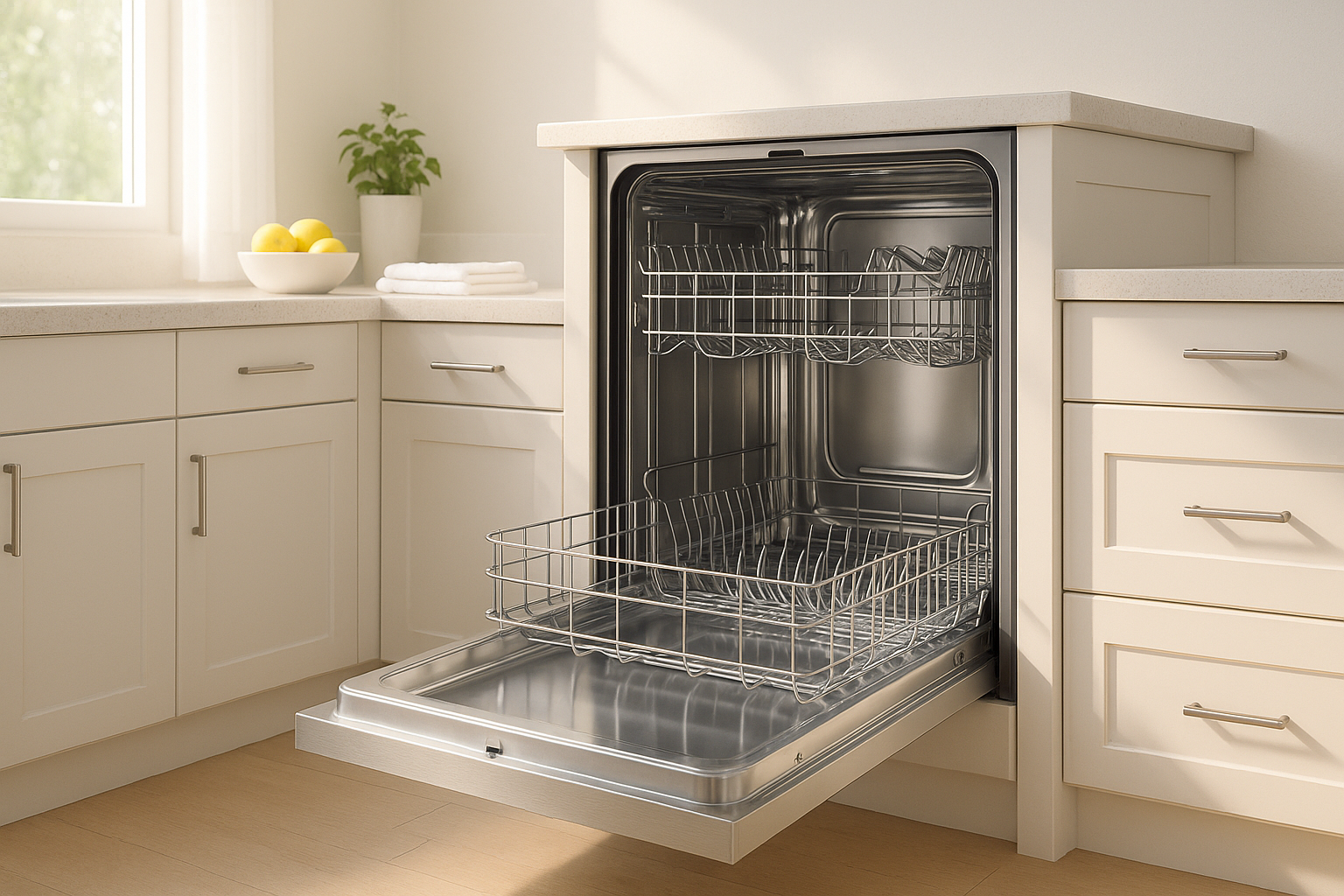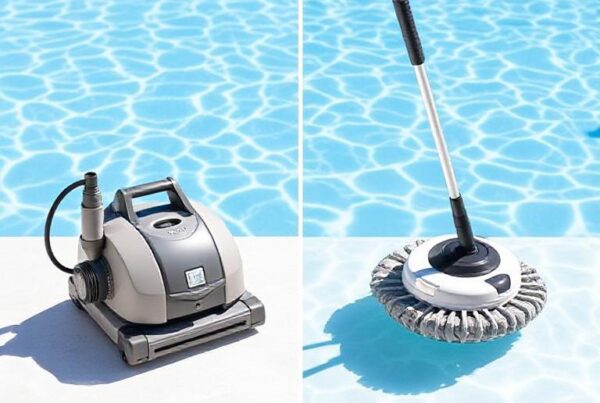Ever noticed how cleaning a smelly dishwasher becomes an urgent priority when you open the door to a wave of unpleasant odors? You’re not alone. Surprisingly, 20% of Americans admit to never cleaning their dishwasher, mistakenly believing that appliances that clean other things should naturally clean themselves.
When your dishwasher smells bad, several culprits could be responsible. Food residue buildup on interior walls, mold growing on gasket seals, or a clogged drain are the most common causes. Specifically, if you detect a fishy or rotten food smell, it is likely due to a clogged filter or drain. Furthermore, a sewage or wet dog odor might indicate more serious drainage problems. Fortunately, deodorizing your dishwasher and eliminating these smells is possible with some targeted cleaning.
In this guide, you’ll discover how to clean a smelly dishwasher with simple 5-minute fixes, including how to clean the dishwasher filter (which experts recommend doing monthly) and how to clean the smelly dishwasher drain hose when food particles accumulate.
Step 1: Empty the dishwasher and gather supplies
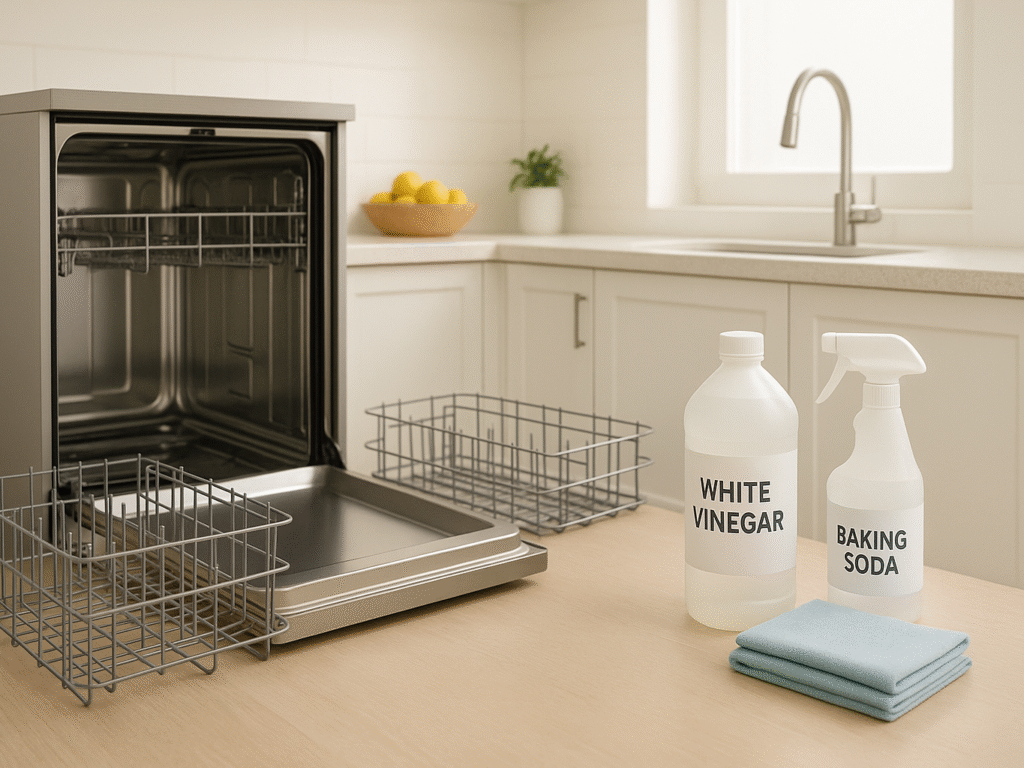
The first step in tackling your smelly dishwasher is to clear the deck for action. Before diving into the cleaning process, you’ll need an empty machine and the right arsenal of cleaning supplies.
(i) Why starting with an empty dishwasher matters
Starting with an empty dishwasher isn’t just smart, it’s necessary. Removing all items ensures full access to interior surfaces where odors form. Skipping this step limits the effectiveness of cleaning and allows hidden grime to remain untouched, causing unpleasant smells to return quickly.
Take out dishes, utensils, racks, and holders. It clears the way for thorough cleaning around filters, seals, and drains, which are familiar sources of odor. An empty interior also allows for better circulation of cleaning agents, such as vinegar and baking soda, which significantly enhances your results.
This step takes only 5–7 minutes but delivers long-term benefits. It keeps your dishwasher cleaner, prevents odor buildup, and supports daily kitchen efficiency when learning how to clean a smelly dishwasher. Making it part of your routine ensures a tidier space and saves time in future cleanups.
(ii) Basic tools and cleaners you’ll need
Now that your dishwasher stands empty, gathering the right cleaning supplies ensures you can attack any smelly situation effectively. The good news? You likely already have most of these items in your home.
Here’s what you’ll need for a complete dishwasher cleaning:
- White distilled vinegar: A natural deodorizer and descaler that breaks down mineral deposits and food residue
- Baking soda: Excellent for neutralizing odors and providing gentle scrubbing power
- Dish soap: Helps remove grease and grime from visible surfaces
- Old toothbrush: Helps clean tight spaces and small crevices
- Clean, dry towel: For drying components after cleaning
- Flexible wire (like a straightened paper clip): Useful for clearing tiny holes and jets
Commercial dishwasher cleaners are effective for tackling tough grime or mineral buildup, but most households find that white vinegar and baking soda are sufficient. For detailed instructions on using these natural cleaners, check out our comprehensive guide on how to clean a dishwasher with vinegar and how to clean a dishwasher with baking soda. Just don’t mix them; use vinegar in one cycle and baking soda in the next. It preserves their cleaning power and maximizes the effectiveness of deodorizing and descaling.
Cleaning your dishwasher filter and drain hose is essential for eliminating odors. Experts recommend monthly filter cleanings to prevent buildup. Routine maintenance and small habits, such as pre-rinsing dishes, make a big difference. Knowing how to clean a smelly dishwasher through consistent care keeps your appliance running efficiently due to lingering, unpleasant smells.
(iii) Recommended Products
| Product Category | Description | Price Range | Use Case | Amazon Link |
| White Vinegar | Pure distilled white vinegar for natural cleaning and deodorizing | $4-6 | Natural deodorizer and descaler for breaking down mineral deposits | Amazon Link |
| Baking Soda | Food-grade baking soda for odor neutralization and gentle scrubbing | $3-5 | Neutralizing odors and providing gentle scrubbing power | Amazon Link |
| Dishwasher-Safe Bowl | Heat-resistant glass bowl for holding vinegar during cleaning cycles | $8-12 | Holding vinegar during dishwasher cleaning cycles | Amazon Link |
| Microfiber Cloths | Lint-free, non-abrasive cloths for wiping surfaces | $10-15 | Wiping down accessible surfaces and drying components | Amazon Link |
Step 2: How to clean a smelly dishwasher filter properly
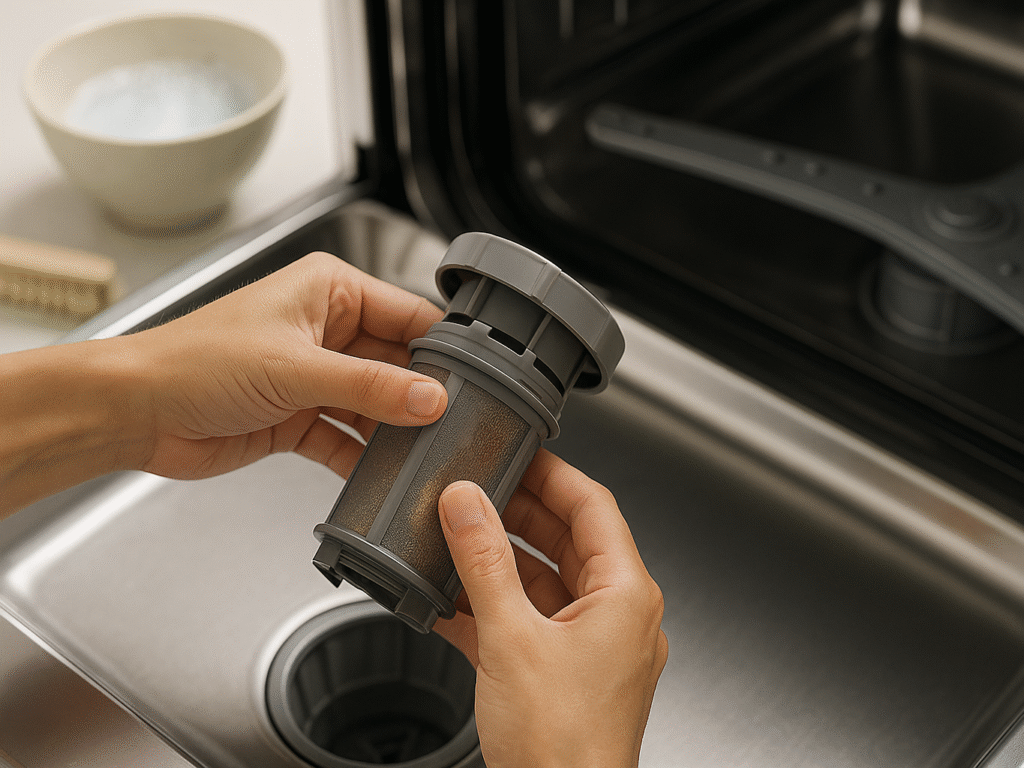
When learning how to clean a smelly dishwasher, the filter is likely the prime suspect. Much like a car’s oil filter, learning how to clean a dishwasher filter is essential since it traps food particles and prevents them from recirculating onto your clean dishes. When neglected, this crucial component becomes a breeding ground for bacteria and the source of that unmistakable funk.
(i) Where to find the filter
First and foremost, locating your dishwasher filter requires accessing the bottom of the appliance. The filter typically sits at the bottom of your dishwasher tub, underneath the bottom rack. To expose it:
- Obliterate the lower dish rack and set it aside
- Look in one of two places: either in the back corner of the dishwasher tub or around the base of the bottom spray arm
Different dishwasher models have slightly different filter designs, so your owner’s manual provides the most accurate location information for your specific model. Generally, newer dishwashers have manual filters that resemble small cylindrical cups, while older models may have self-cleaning filters with built-in grinders that pulverize food particles.
Before attempting any cleaning, take a moment to identify the type of filter you have. If you see a removable cylindrical part at the bottom of the dishwasher tub, you have a manual filter that requires regular cleaning.
(ii) How to remove and clean it
Once you’ve located the filter, removing it requires a gentle touch. Many dishwasher filters consist of two parts: an upper filter assembly and a lower filter. Here’s how to safely remove both components:
- For the upper filter assembly (cylindrical part), give it a quarter turn counterclockwise and lift it out
- For the lower filter, gently grasp it, lift slightly, and pull forward to remove completely
Handle the filter carefully, as a damaged filter can lead to poor dishwasher performance.
After removal, knowing how to clean the dishwasher filter requires cleaning both components thoroughly:
- Rinse the filter under warm running water to remove loose debris
- For stubborn food particles that don’t rinse away easily, soak the filter in warm water for a few minutes
- Use a soft brush (like an old toothbrush), sponge, or bottle brush to clean any hard-to-reach areas gently
- For calcium deposits or particularly stuck-on food bits, apply gentle scrubbing with the soft brush
Never use wire brushes, scouring pads, or any abrasive materials that might damage the filter mesh. It can create holes that allow food particles to pass through and potentially damage your dishwasher’s pump and motor.
For filters that need a deeper cleaning due to significant buildup or persistent odors, try this natural solution:
- After initial rinsing, soak the filter in a mixture of white vinegar and warm water for at least 30 minutes. This method is part of our complete dishwasher cleaning guide that covers every component systematically.
- Afterward, rinse thoroughly with warm water and dry with a microfiber cloth before reinstallation.
To reinstall your now-clean filter:
- Return the lower filter to the bottom of the dishwasher tub, positioning it properly under the tabs
- Place the upper filter into the opening in the top of the lower filter
- Turn the filter clockwise until it drops into position and locks securely
- If the filter still turns freely, it’s not seated correctly. Keep turning clockwise until it locks.
A securely installed filter is essential when you know how to clean a smelly dishwasher properly. Indeed, running your dishwasher with improperly installed filters can damage the appliance and reduce cleaning effectiveness.
Why Your Dishwasher Smells Like Sewage (And How to Fix It Today): Discover the hidden causes behind that awful sewage smell in your dishwasher and learn professional techniques to eliminate it permanently. Get expert solutions for even the most challenging odor problems.
(iii) How often should you clean the filter?
Cleaning frequency recommendations vary among manufacturers and depend on your dishwasher usage patterns. As a general guideline, cleaning your dishwasher filter every three to six months helps maintain peak performance.
Nonetheless, several factors affect how often you should clean your filter:
- Usage frequency: More frequent use requires more frequent cleaning
- Pre-rinsing habits: Bosch suggests cleaning three to six times yearly if you rinse dishes beforehand, but four to 12 times yearly if you don’t
- Water hardness: Hard water areas may require more frequent cleaning due to mineral buildup
- Dishware condition: If you’re not scraping large food particles before loading
Miele dishwashers notify users every 50 wash cycles to check their filter, which provides a good benchmark for average households.
You might need to clean your filter more frequently if you notice:
- Visible soil or residue on the upper filter assembly
- Declining cleaning performance (food remains on dishes after a cycle)
- Gritty feeling on dishes after washing
- Dishes or glasses getting scratched or etched by debris
- Unpleasant odors when opening the dishwasher
For households that run the dishwasher daily, monthly filter checks are advisable. At minimum, a quick visual inspection of the filter when emptying the dishwasher helps catch potential issues before they affect performance or create persistent odors.
Some cleaning experts recommend checking your filter at least once a month, regardless of usage patterns. This quick maintenance step takes just minutes but prevents the much larger task of dealing with a severely clogged filter and foul-smelling dishwasher.
Remember that a clean filter not only eliminates odors but also improves cleaning performance, extends your appliance’s lifespan, and prevents potentially costly repairs. In learning how to clean a smelly dishwasher, maintaining a clean filter represents your first line of defense.
(iv) Recommended Products
| Product Category | Description | Price | Use Case | Amazon Link |
| Dishwasher Cleaning Kit | Professional cleaning tools with pick, scraper, straw brush, gap & angle brush | $12-18 | Deep cleaning the dishwasher filter and removing food residue | Amazon Link |
| Soft-Bristled Brush | Angled head with stiff, durable bristles for cleaning nooks and crannies | $8-12 | Scrubbing filter without damaging the mesh material | Amazon Link |
| Cleaning Toothbrush | Soft bristles are perfect for reaching tight spaces in the filter | $3-5 | Cleaning small crevices and detailed areas of the filter | Amazon Link |
| Bottle Brush | Long handle with flexible head for cleaning cylindrical parts | $6-10 | Cleaning the interior of cylindrical filter components | Amazon Link |
Step 3: Wipe down the interior and door seals
After tackling the filter, the next breeding ground for unpleasant odors is the interior surfaces and rubber seals of your dishwasher. Even with a clean filter, mastering how to clean a smelly dishwasher means addressing areas that might still smell bad if these areas harbor food residue, mold, or mildew.
(i) Focus areas: walls, racks, and door lip
Once you’ve removed the racks from your dishwasher, you’ll notice several areas where grime can accumulate. The interior walls, bottom of the door, and corners often collect mineral deposits, limescale, and sometimes grease over time. These buildups not only affect your dishwasher’s performance but can leave your glassware cloudy and dishes with stuck-on food particles.
To clean these surfaces effectively:
- Use a damp microfiber cloth or sponge to wipe away residue from the inside of the door, including the door edges and control panel.
- Pay special attention to the door lip, the area where the door meets the tub when closed.
- Inspect the walls of the dishwasher for any food particles or residue.
- For stubborn stains, a solution of warm water and white vinegar is effective in breaking down deposits.
The racks themselves also require attention. Food particles can easily become trapped in the wire construction. Although you removed them earlier, take time to inspect and clean them thoroughly. This step is often overlooked yet critical in eliminating persistent odors from a smelly dishwasher.
(ii) How to clean the rubber gasket
The rubber gasket, which seals around the dishwasher door, is the most critical area to clean when dealing with dishwasher odors. This component creates a water-tight barrier during wash cycles, yet its design makes it perfect for trapping food particles and moisture.
To clean the gasket thoroughly:
- Locate the rubber seal that lines the door of your dishwasher.
- Gently clean the gasket with a soft toothbrush to remove grime from tough-to-reach crevices without putting pressure on the seal.
- Use a solution of three cups of hot water mixed with a half cup of vinegar for cleaning.
- For gaskets with visible mold or mildew, you may need an all-purpose cleaner; however, first check your manufacturer’s instructions.
Some dishwashers have specific cleaning recommendations. Certain manufacturers advise cleaning only with warm water to avoid damaging the gasket. If you notice a sewage-like smell coming from your dishwasher, it might indicate more serious issues that require immediate attention: learn more about why your dishwasher smells like sewage and how to fix it. Accordingly, always consult your dishwasher’s manual before using any cleaner besides water.
The gasket requires regular attention, checking it at least once a year to ensure it’s functioning correctly. Gaskets that appear cracked, torn, or misshapen should be replaced immediately to prevent leaks. Furthermore, experts recommend cleaning this area at least once a month, as it’s the primary location where mold and bacteria accumulate.
(iii) Preventing mold and mildew buildup
Mold thrives in dark, moist environments, precisely what your closed dishwasher provides between cycles. Fortunately, several simple habits can dramatically reduce mold and mildew growth.
Firstly, dry the gasket thoroughly with a paper towel after cleaning. Leaving moisture on the rubber creates an ideal environment for the growth of new mold. This small step makes a significant difference in preventing future odors.
The combination of heat, moisture, and darkness means mold can quickly establish itself if your dishwasher isn’t kept clean and dry when not in use. One of the most effective prevention techniques is surprisingly simple: leave your dishwasher door slightly ajar between cycles. It allows airflow to dry out the damp environment within your dishwasher, essentially eliminating one of the conditions mold needs to thrive.
For ongoing maintenance, spray down the entire inside with a mixture of vinegar, baking soda, and water about once a month. This practice prevents mold from taking hold, keeping your dishwasher clean and fresh.
For those dealing with persistent mold issues, consider these additional preventative measures:
- Keep the door gasket clean after every cycle with a dry cloth
- Clean the filter weekly instead of monthly if mold is a recurring problem
- Deep clean your dishwasher every 1-3 months, depending on usage frequency
- Regularly inspect the drain hose for clogs that might cause water to back up
Speaking of the drain hose, this component often contributes to dishwasher odors when food particles accumulate there. The drain hose inspection will be covered in detail in Step 5 of our guide, where you’ll learn specific techniques for addressing this common odor source.
Remember that maintaining a clean interior and gasket isn’t just about eliminating unpleasant smells; it’s also about ensuring your dishwasher functions properly and lasts longer. Clean seals prevent leaks, and clean interiors improve cleaning performance, making this maintenance step well worth the small time investment.
(iv) Recommended Products
| Product Category | Description | Price Range | Use Case | Amazon Link |
| All-Purpose Cleaner | Natural cleaning solution is safe for dishwasher surfaces | $4-6 | Cleaning interior walls and door surfaces | Amazon Link |
| Scrub Sponges | Dual-sided sponges for gentle scrubbing without scratching | $8-12 | Removing stubborn stains from interior surfaces | Amazon Link |
| Rubber Gasket Cleaner | Specialized cleaner for rubber seals and gaskets | $6-9 | Cleaning and maintaining rubber door seals | Amazon Link |
| Detail Cleaning Brushes | Small brushes for reaching tight spaces around seals | $7-10 | Cleaning detailed areas around door gaskets | Amazon Link |
Step 4: Deodorize dishwasher with vinegar and baking soda
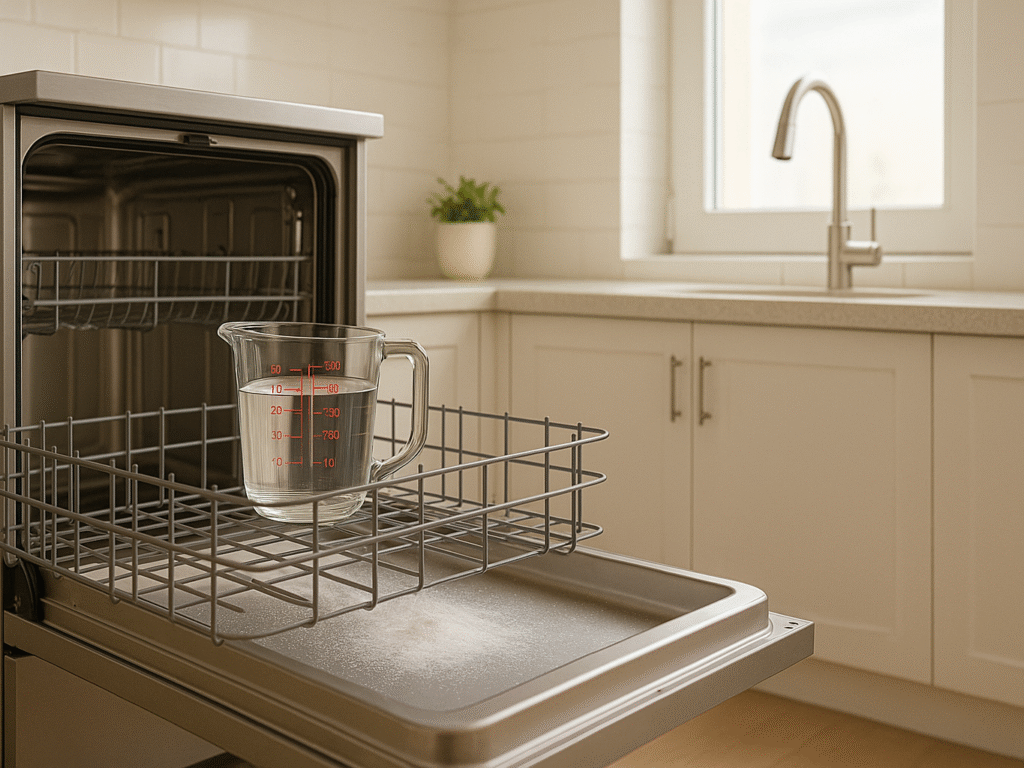
Vinegar and baking soda are powerful natural cleaners that work wonders on persistent odors in dishwashers. These kitchen staples are essential when understanding how to clean a smelly dishwasher, effectively breaking down grease, food residue, and mineral deposits that often cause your dishwasher to have an unpleasant odor. Yet, using them correctly requires understanding their unique properties and applying them properly.
(i) How to use vinegar safely
White distilled vinegar excels at breaking down grease, food residue, and mineral deposits thanks to its acidic properties. For a complete understanding of vinegar’s cleaning power, explore our detailed vinegar cleaning method that includes professional tips and safety guidelines. For optimal results:
- Fill a dishwasher-safe bowl with 1-2 cups of white vinegar
- Place the bowl upright on the top rack of your empty dishwasher
- Run the dishwasher on a hot water cycle without detergent
- Turn off the heat dry option to save energy
This process enables the vinegar to mix with the wash water throughout the cycle, helping to neutralize odors and clean the interior surfaces simultaneously. For stubborn odors, consider using cleaning vinegar, which is approximately 20% stronger than regular distilled white vinegar.
Important safety note: Vinegar’s high acidity (pH around 2.0) can potentially damage rubber gaskets and seals if misused. To prevent this, always keep the vinegar contained in a bowl rather than pouring it directly into the dishwasher or detergent dispenser. This controlled approach protects your dishwasher while still achieving effective cleaning.
(ii) When to use baking soda instead
Baking soda serves as an excellent alternative or complement to vinegar cleaning, primarily for its deodorizing properties and gentle scrubbing action. Our comprehensive baking soda cleaning guide provides eight detailed steps for maximum effectiveness. Consider using baking soda when learning how to clean a smelly dishwasher with persistent odors
- Your dishwasher has persistent odors even after vinegar cleaning
- You’re concerned about vinegar’s acidity on your appliance
- You want to boost cleaning power after a vinegar cycle
To use baking soda effectively:
- After completing a vinegar cycle, remove the empty bowl
- Sprinkle 1 cup of baking soda along the bottom of the dishwasher
- Run a short hot water cycle (skip the heat dry option)
Baking soda’s natural alkalinity (pH of 9) makes it highly effective at neutralizing odors and cutting through grease stains. Furthermore, its gentle abrasive quality helps remove stubborn residue without scratching surfaces.
For exceptionally smelly dishwashers, following up a vinegar cycle with a baking soda cycle provides comprehensive cleaning. The baking soda neutralizes any remaining vinegar while adding its deodorizing properties.
How to Clean a Dishwasher with Baking Soda: An 8-Step Guide: Master the art of cleaning your dishwasher with baking soda using our comprehensive 8-step method. Discover advanced techniques that surpass basic maintenance for exceptional results.
(iii) Why you shouldn’t mix them
Although vinegar and baking soda are powerful cleaners individually, they should never be mixed. When combined, they react to form carbon dioxide and water. This fizzing may look effective, but it neutralizes both ingredients, leaving behind nothing more than weak saltwater.
This reaction reduces vinegar’s ability to dissolve mineral deposits and weakens baking soda’s grease-cutting power. For the best results, use them in separate cycles. Start with vinegar to break down buildup, then use baking soda to neutralize odors and freshen the interior.
Using this two-step method ensures maximum cleaning without causing foaming or overflow. Regular monthly maintenance using these natural ingredients helps keep your dishwasher fresh. Combined with proper filter and drain hose cleaning, it prevents bad smells and the need for heavy scrubbing later
(iv) Recommended Products
| Product Category | Description | Price | Use Case | Amazon Link |
| Cleaning Vinegar | 6% acetic acid: stronger than regular vinegar for tough jobs | $3-5 | Heavy-duty deodorizing and mineral deposit removal | Amazon Link |
| Pure Baking Soda | Pure sodium bicarbonate for effective odor neutralization | $2-4 | Neutralizing persistent odors after vinegar treatment | Amazon Link |
| Glass Mixing Bowl | Heat-resistant glass bowls for mixing and holding cleaning solutions | $12-18 | Holding a vinegar solution during cleaning cycles | Amazon Link |
| Measuring Spoons | Accurate measuring tools for proper cleaning solution ratios | $8-12 | Measuring correct amounts of vinegar and baking soda | Amazon Link |
Step 5: How to clean a smelly dishwasher drain hose
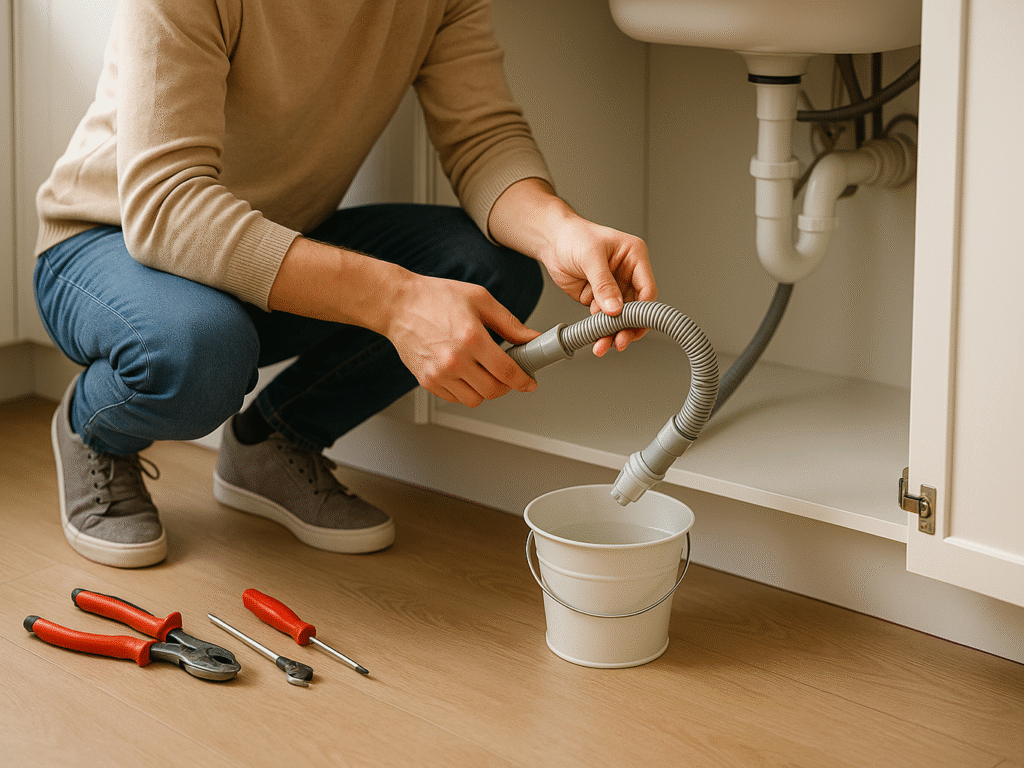
When learning how to clean a smelly dishwasher, the drain hose often goes unnoticed until it becomes a source of persistent odors in the dishwasher. This hidden component connects your dishwasher to the garbage disposal or sink drain, creating the perfect environment for food particles and debris to accumulate over time.
(i) Signs Your Drain Hose Might Be Clogged.
Several signs indicate your dishwasher’s drain hose needs attention. Standing water after a wash cycle signals poor drainage. It typically means a blockage is preventing water from exiting properly. If left unattended, stagnant water can lead to foul odors, bacterial buildup, and reduced dishwasher performance over time.
Even after cleaning the filter and interior, unpleasant smells may linger. These often result from food debris being trapped inside the drain hose. As this organic matter decomposes, it produces a strong, rotten odor. Gurgling sounds during wash cycles also point to partial clogs, as water struggles to push through blockages.
You might notice water backing up into your kitchen sink when the dishwasher drains, a strong sign that both share a clogged pipe. Simultaneous slow draining in the sink and dishwasher confirms this. These interconnected drainage issues should be addressed promptly to prevent overflow, water damage, and deterioration of appliance performance.
(ii) How to inspect and clean it
Once you suspect drain hose issues, follow these steps to learn how to clean the smelly dishwasher drain hose properly:
- Locate the hose: The drain hose typically runs from the back of your dishwasher to the area underneath your sink, connecting to either the garbage disposal or the sink drain pipe.
- Prepare the area: Place towels under the connection points to catch any water that may drip. Unplug your dishwasher or turn off its circuit breaker for safety.
- Check for kinks: Before disconnecting anything, inspect the visible portions of the hose for bends or kinks that restrict water flow.
- Disconnect for inspection: Use pliers to loosen the clamp securing the hose at either the dishwasher or sink end. Have a bucket ready to catch water.
- Test for blockages: Try blowing through the hose to check for clogs. If air doesn’t pass through easily, you’ve found your problem.
- Clean the hose: For minor clogs, flush the hose with hot water or a mixture of equal parts vinegar and baking soda (applied separately). For stubborn blockages, use a straightened wire coat hanger to dislodge debris from the ends carefully.
Even though you’ve already cleaned your dishwasher filter in Step 2, this additional drain hose cleaning addresses another common source of dishwasher odors. Remember not to use a plumber’s snake on your drain hose as it can easily puncture the plastic material.
(iii) When to call a professional
Sometimes, at-home solutions aren’t enough to resolve drain hose issues. Consider professional assistance in these situations:
- Persistent standing water that remains after attempting DIY cleaning suggests a clog beyond your reach or potentially a more serious plumbing issue.
- Recurring clogs despite regular maintenance might indicate problems with your home’s plumbing system rather than just the dishwasher itself.
- Damaged hose components that show cracks, leaks, or severe deterioration require replacement. An old drain hose can accumulate sediment buildup that restricts flow over time.
- Frequent blockages often signal it’s time for professional intervention. Trained plumbers can identify and resolve deeper clogs using specialized equipment, such as cameras and hydro jets.
Remember that dishwasher repairs can be expensive; therefore, proactive maintenance of your drain hose is a more economical option than waiting for major problems to develop. For comprehensive maintenance strategies, refer to our complete dishwasher cleaning guide that covers all components systematically. For persistent issues, contact a professional plumber who can thoroughly diagnose and fix the problem without risking damage to your appliance.
(iv) Recommended Products
| Product Category | Description | Price | Use Case | Amazon Link |
| Drain Snake | Flexible drain cleaning tool for removing clogs | $8-12 | Clearing blockages from the drain hose | Amazon Link |
| Pliers Set | Multi-purpose pliers for loosening hose clamps | $15-20 | Disconnecting the drain hose clamps safely | Amazon Link |
| Hose Brush | Long flexible brushes for cleaning inside hoses | $6-10 | Scrubbing the interior of the drain hose | Amazon Link |
| Bucket | A bucket for catching water during hose cleaning | $12-16 | Collecting water when disconnecting the drain hose | Amazon Link |
Step 6: Run a hot cycle and let it air dry
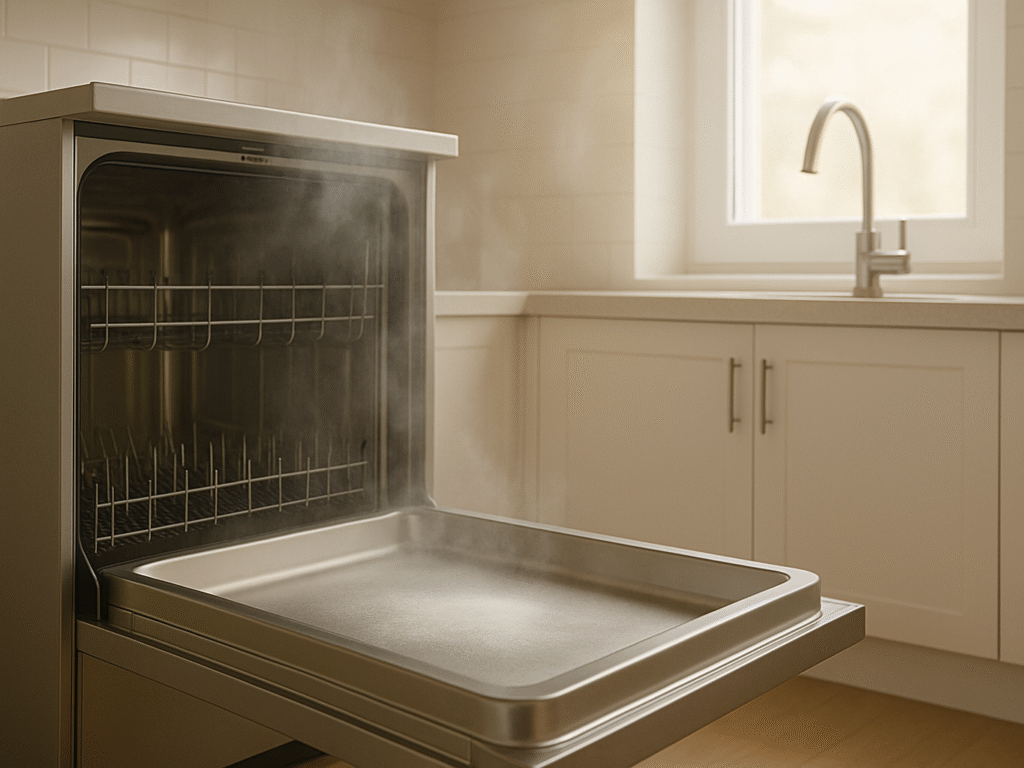
After completing the physical cleaning steps, your dishwasher needs one final treatment to eliminate lingering odors. This crucial step in how to clean a smelly dishwasher involves running a hot cycle followed by proper air drying. This combination attacks remaining bacteria and prevents new odors from forming.
How to Clean Your Dishwasher: A Step-by-Step Guide to Remove Smells & Grime: Get our complete dishwasher cleaning blueprint that covers every component and technique. This detailed guide ensures your appliance stays fresh and functions perfectly for years.
(i) Why does hot water help remove odors
Hot water serves as a powerful weapon against dishwasher odors for several reasons. Initially, heat dissolves grease and food residue that cold water cannot tackle. When water reaches higher temperatures, it breaks down stubborn residue that might remain even after you’ve cleaned the filter and wiped down surfaces.
The high-temperature water typically works in conjunction with your cleaning agents (such as vinegar or baking soda from previous steps) to maximize their effectiveness. Hot water ultimately creates an inhospitable environment for odor-causing bacteria, as many cannot survive these elevated temperatures.
Furthermore, hot water agitates molecules more vigorously, helping detergent or cleaning solutions penetrate tiny crevices throughout your appliance. This enhanced cleaning action reaches areas you might have missed during manual cleaning of the filter or drain hose.
For optimal results, try running the hot water faucet at the sink closest to your dishwasher until it’s hot before starting the cycle. It ensures hot water enters your dishwasher immediately rather than wasting time heating up.
(ii) Tips for air drying your dishwasher
Once the hot cycle completes, proper drying prevents new odors from forming. Consider these practical approaches:
- Skip the heat dry setting: Heat drying consumes approximately 15% more energy than air drying. Occasionally, using the heat dry cycle makes sense for sanitizing purposes, yet for regular maintenance cleaning, air drying works perfectly.
- Use the air-dry setting: Many modern dishwashers feature an air-dry setting that circulates room temperature air throughout the machine without using the heating element.
- Open the door slightly: For dishwashers without an air-dry setting, crack open the door after the cycle finishes. This flash-drying technique allows hot, moist air to escape, typically taking only 2-10 minutes, depending on your model.
- Let it air fully: For thorough drying and maximum odor prevention, leave the door slightly ajar for 6-8 hours or overnight.
This final step in cleaning a smelly dishwasher complements your earlier efforts to clean the dishwasher filter and drain hose. If you suspect the sewage smell persists despite these efforts, check out our specialized guide on dishwasher sewage odors for advanced troubleshooting techniques. Together, these actions create a comprehensive approach to eliminating unpleasant odors.
Fortunately, unlike the more labor-intensive tasks of filter cleaning or drain hose inspection, this step requires minimal effort yet yields significant results in your quest to deodorize your dishwasher thoroughly.
(iii) Recommended Products
| Product Category | Description | Price | Use Case | Amazon Link |
| Dishwasher Cleaner | Commercial dishwasher cleaner for deep cleaning cycles | $8-12 | Running final cleaning cycle for thorough deodorization | Amazon Link |
| Thermometer | Checking water temperature for optimal cleaning | $10-15 | Ensuring hot water temperature reaches proper levels | Amazon Link |
| Drying Towels | Super absorbent towels for drying the dishwasher interior | $12-18 | Quick drying of interior surfaces after cleaning | Amazon Link |
| Air Freshener | Odor eliminator for the kitchen area during cleaning | $4-6 | Freshening kitchen air during and after the cleaning process | Amazon Link |
Step 7: Prevent future smells with regular maintenance
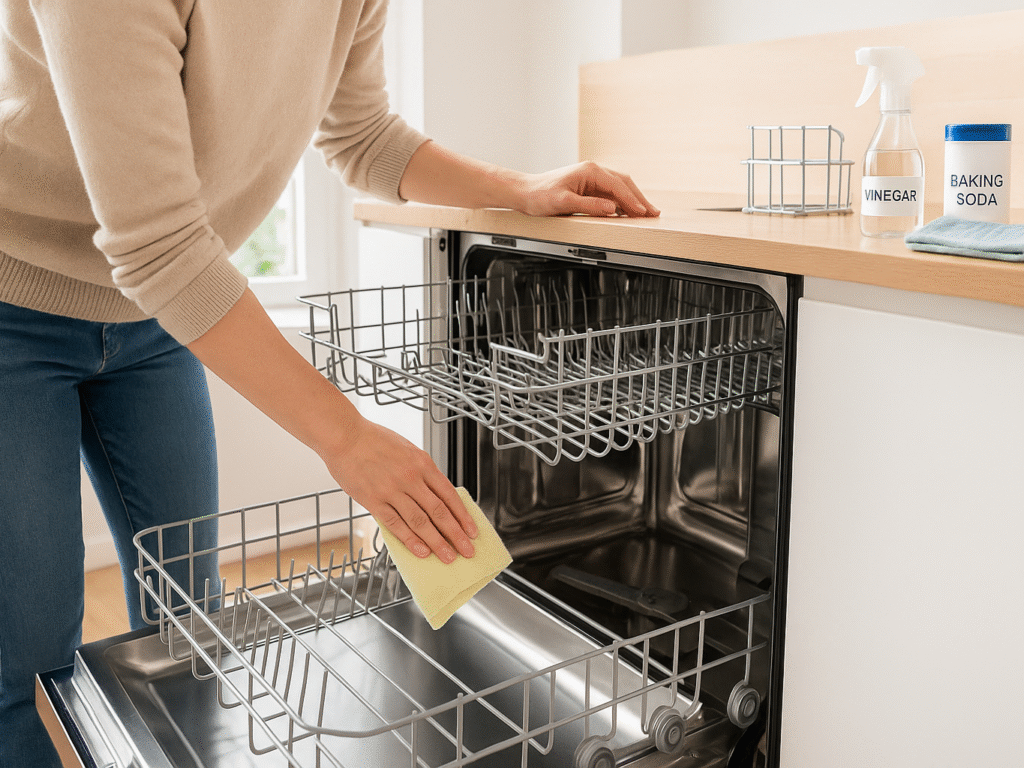
Knowing how to clean a smelly dishwasher means maintaining an appliance that stays odor-free through ongoing effort. Even with a thorough deep clean, odors can return without regular maintenance. Creating a consistent routine for how to clean a smelly dishwasher helps prevent odors from developing as you continue to use your appliance.
(i) Monthly cleaning checklist
To maintain a fresh-smelling dishwasher, follow this simple schedule:
- After each load, remove any visible food particles from the bottom of the dishwasher
- Weekly: Learn how to clean the dishwasher filter to prevent clogs and buildup
- Monthly: Deep clean using the vinegar and baking soda method: for detailed instructions, visit our guides on cleaning with vinegar and cleaning with baking soda. Quarterly: Inspect spray arms and run a cleaning cycle with citric acid.
- Quarterly: Inspect spray arms and run a cleaning cycle with citric acid
For areas with hard water, you may need to clean more frequently to remove mineral buildup. Simply scraping dishes before loading them can significantly reduce the frequency of future dishwasher odors.
(ii) Best practices for loading dishes
Proper loading isn’t just about clean dishes; it’s also crucial for preventing odors. Avoid overstuffing racks to allow water and detergent to flow freely. Place items between, not on top of, the dishwasher’s tines to ensure proper cleaning.
Plus, always check that the spray arms can rotate freely after loading. If they hit anything, rearrange your dishes, as blocked spray arms lead to poor cleaning and food residue buildup.
As for pre-rinsing, merely scrape food off rather than pre-washing dishes. Today’s dishwashers work better with some food residue for the detergent to act upon.
(iii) Recommended Products
| Product Category | Description | Price | Use Case | Amazon Link |
| Monthly Cleaner | Regular maintenance cleaner for monthly use | $6-9 | Preventing future odor buildup with regular cleaning | Amazon Link |
| Rinse Aid | Prevents water spots and improves drying performance | $4-7 | Maintaining clean dishes and preventing residue buildup | Amazon Link |
| Citric Acid | Natural descaler for hard water mineral removal | $6-10 | Quarterly deep cleaning to remove mineral deposits | Amazon Link |
| Cleaning Schedule Chart | Weekly/monthly cleaning schedule tracker | $8-12 | Tracking regular maintenance to prevent future odors | Amazon Link |
Final Thoughts
Learning how to clean a smelly dishwasher is easier than it seems. Simple maintenance steps, such as regularly cleaning the filter, can help eliminate odor-causing food buildup. Remove the cylindrical filter at the bottom, rinse thoroughly, and scrub off residue. This basic habit tackles most unpleasant smells before they spread throughout your kitchen.
Knowing how to clean a smelly dishwasher drain hose is just as crucial. Food particles often collect inside, creating a breeding ground for bacteria and odors. Periodically inspect the hose and flush it out. Combining this with a cleaning routine that uses white vinegar and baking soda helps remove mineral buildup, neutralize odors, and keep everything fresh.
To prevent future odor issues, load dishes properly, leave the door slightly open between uses, and do monthly maintenance checks. These small steps reduce moisture buildup and stop mold growth. By mastering how to clean a smelly dishwasher, in just five minutes a month, you can enjoy a fresh-smelling appliance and a cleaner, healthier kitchen environment all year round.

